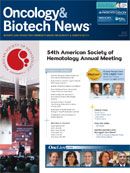Publication
Article
Oncology & Biotech News
Adding Vorinostat to Standard Chemotherapy Reduced the Incidence of Acute GVHD
Author(s):
Vorinostat added to standard chemotherapy before, during, and after hematopoietic stem-cell transplantation reduced the cumulative incidence of graft-versus-host disease.
Pavan Reddy, MD
Vorinostat added to standard chemotherapy before, during, and after hematopoietic stem-cell transplantation (HSCT) reduced the cumulative incidence of graft-versus-host disease (GVHD) in a phase I/II trial reported at the 54th Annual Meeting of the American Society of Hematology (ASH).
This study is an example of successful translation of basic science into a proof-of-concept clinical trial, explained lead author, Pavan Reddy, MD, senior author, co-director, University of Michigan Bone Marrow Transplant and Hematologic Malignancies Program, Ann Arbor. He discussed this abstract at a press conference. Lead author Sung Choi, MD, of the same institution, gave the formal presentation at ASH.
“HSCT is curative for several malignancies. The problem is that it induces GVHD, a major complication of allogeneic HSCT, in about one-third of recipients,” he explained.
In preclinical studies, Reddy et al showed that histone deacetylase (HDAC) inhibitors reduce proinflammatory cytokines, increase T-regulatory cell numbers, and attenuate experimental GVHD in animal models. The study he presented at ASH is the first-in-human trial to evaluate the addition of an HDAC inhibitor (vorinostat) to standard therapy to determine whether the basic science observations would translate to clinical benefit.
“Our hypothesis was that HDAC inhibition would be safe and would reduce GVHD in matched related donor transplant with reduced intensity conditioning,” Reddy said. To that end, he and his colleagues compared results of the phase I/II study with historical controls treated with standard prevention.
The study opened in 2009 and was completed in 2012. Forty-seven patients undergoing HSCT with reduced-intensity conditioning were evaluable. All patients received 100 mg of oral vorinostat twice daily from 10 days before HSCT to 100 days after. Vorinostat was administered along with standard therapy that included fludarabine, busulfan, mycophenolate mofetil, and tacrolimus.
Compared with historical controls, patients in the study were older—mean age of 25 matched controls was 52 years and mean age of study patients was 58 years. The rate of engraftment was similar in both the study group and controls.
OncLive TV Exclusive
Dr. Sung Choi on Vorinostat in GVHD Prevention
As observed in experimental models, levels of histones 3 and 4 were higher in the group treated with vorinostat versus controls. “This suggests that we were using a sufficient dose of vorinostat and this dovetailed with our experimental observations,” Reddy explained.
For the primary endpoint, acute GVHD was observed in 22% of study patients, representing a 20% reduction from the average rate of 42% in historical controls.
“Ninety percent of patients die if they develop grade 4 acute GVHD. The incidence of grade 4 GVHD in our study was 1% compared with 20% in historical controls,” he said.
Vorinostat did not appear to increase side effects. The overall adverse event profile in the trial was similar to historical controls. No fungal infections were reported, and the rate of cytomegalovirus reactivations and bacteremias was similar to historical controls. The causes of death were also no different between the two groups.
“GVHD is a very bad disease. At the same time we need to induce GVHD to fight the cancer. Acute grade 2 GVHD is not a problem, but grades 3 and 4 are associated with a high mortality rate in the first 100 days. Vorinostat decreased the probability of GVHD. Studies of HDAC in patients undergoing allogeneic HSCT are ongoing,” said Vanderson Rocha, MD, press conference moderator, professor of Hematology, Oxford University, United Kingdom.
Choi SW, DiPersio JF, Braun TM, et al. Targeting histone deacetylases as a new strategy for graft versus host disease prevention. Blood. (ASH Annual Meeting Abstracts).
2012;120(21): abstr 740.










